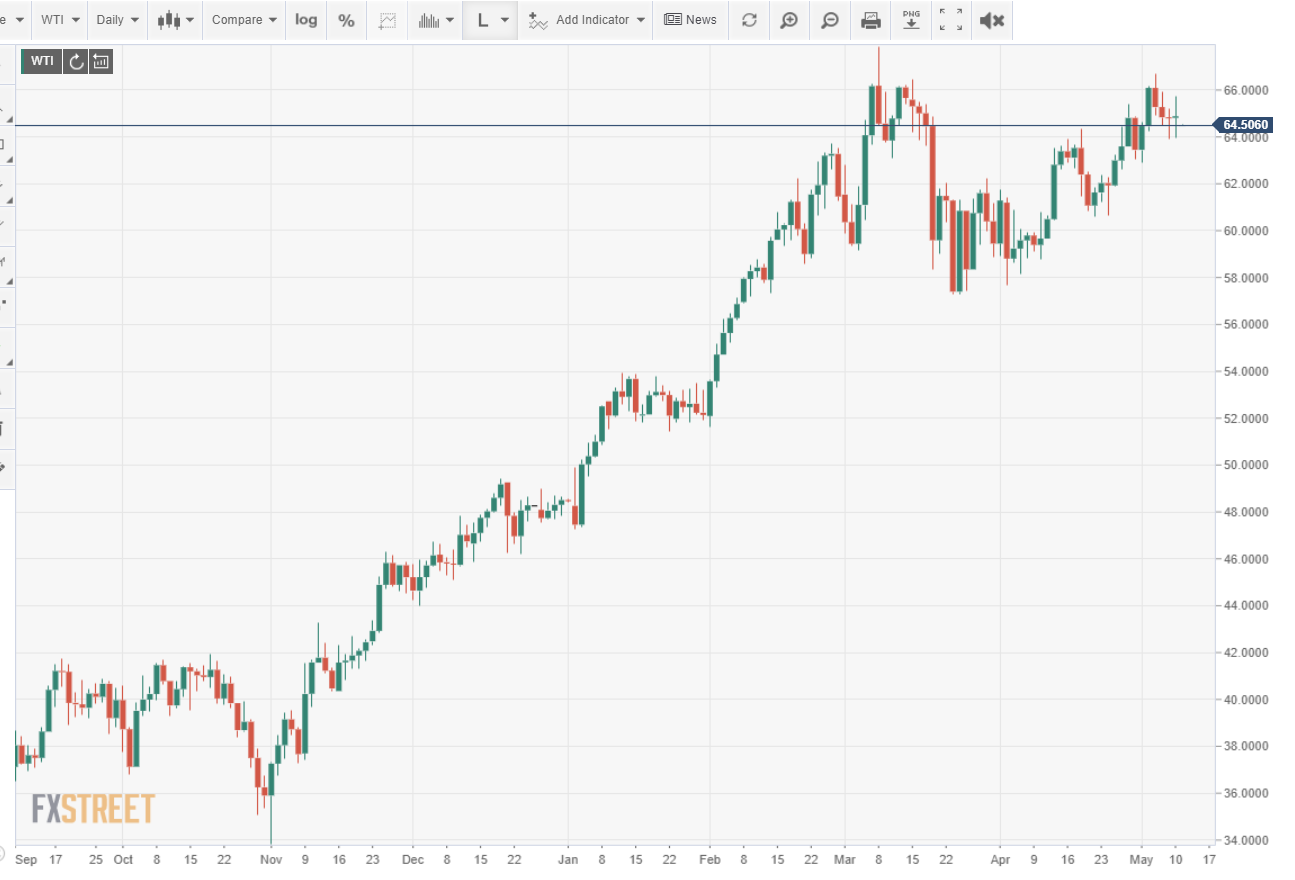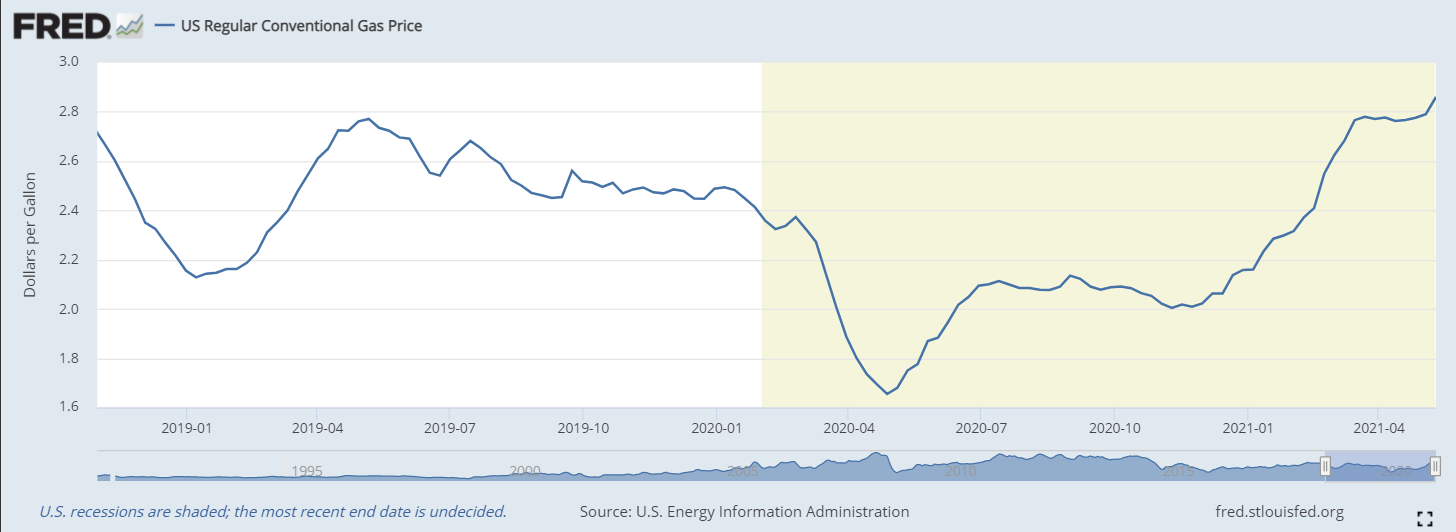- Annual CPI expected to jump 3.6% in April .
- April 2020 had the lowest consumer price index of the pandemic.
- US Gasoline prices are up 43% in six months.
- Federal Reserve foresees no policy changes with inflation.
American consumer prices are set to rise by the most in decade as the base effect from last year’s pandemic collapse reaches its height.
The Consumer Price Index (CPI) is expected to climb 0.2% in April, according to the consensus forecast from the Reuters survey of economists. In March CPI rose 0.6%. Annual prices are projected to jump 3.6% following the 2.6% increase in March.
Core prices are predicted to be unchanged at 0.3% on the month but to rise 2.3% annually in April from 1.6% in March
Consumer Price Index
The Consumer Price Index tracks the change in cost for a basket of goods over time with a reference to a base year as 100.
Last year's lockdown in March and April crushed retailers who were forced to sell goods at discounts or not at all as most consumers limited their purchases to essential items and services.
As the shutdown took hold last spring the index dropped from 258.678 in February to 258.115 in March to the low of 256.389 in April 2020.
Consumer Price Index
Prices began to recover in May, and by July’s 259.101 score the index was above February's pre-lockdown level.
Since last July price increases have averaged 0.3% a month. By March those cumulative gains had produced an index level of 264.877, or 2.62% above the 258.115 last March.
The same comparison with the April 2020 index is projected to produce a 3.3% gain this year.
CPI
FXStreet
Consumer prices base effect vs demand shortage
The quickly reviving US economy and government pandemic largesse have invigorated consumption. Retail Sales averaged 4.8% for the first quarter, which, except for the May, June and July rebound from the prior collapse, was the strongest quarter for sales in two decades.
The rebound has exposed numerous shortages in goods and services, due to backorders, and scare components and materials. Prices have jumped for some goods and more increases are likely as the economy fully opens and normal life resumes.
In addition, energy costs, which factor into almost all consumer goods, have risen sharply since the presidential election last November.
A barrel of West Texas Intermediate (WTI), the North American pricing standard, has climbed 79.7% since it opened at $35.90 on November 2 the day before the vote.
WTI
Gasoline prices have gone up in tandem. From a nationwide average of $2.02 a gallon on November 2, prices have climbed 43% to $2.86 on May 10. The gains are a compound of rising demand as the pandemic has waned and the Biden administration’s energy policy, which has eliminated all new oil production leases on federal land.
Federal Reserve inflation policy
The Federal Reserve anticipated the steep increases in the CPI this year when the governors adopted an inflation-averaging policy last September. Once economic recovery began the jump in CPI was a mathematical certainty as long as prices resumed a normal course.
This new guideline permits inflation to run above target for a long enough and unspecified period to generate a 2% overall average.
By this change the Fed has disabled its reaction function. In the past, inflation above 2% for more than a month or two, would have sent credit markets speculating about a rate increase.
The purpose of the new stipulation was to give the central bank much greater freedom to maintain accommodative rates, regardless of price variation.
Conclusion
Fed Chair Jerome Powell and other officials have said repeatedly that the current spate of price increases are a limited phenomenon, attributable largely to the base effect from last year's lockdown. In that they are correct. The March and April CPI jumps are transitory. These increases in CPI will not and should not tempt the governors into preventative rate measures.
But these are not the only factors operating on consumer prices. Demand is increasing for many consumer goods. For some, bicycles for instance, production delays and a shortage of parts are keeping supply limited.
Employers are beginning to offer higher wages because in many industries they cannot find enough workers.
This combination of rising retail demand, scarcity for some consumer goods and incipient wage gains may, if they continue, raise the base rate of consumer inflation expectations.
The Fed insists that all three problems are temporary, the products of manufacturing and labor shortages that will ease as the economy fully recovers.
For markets, whether the Fed’s inflation analysis proves accurate is, for the moment, irrelevant. There is no CPI result that will prompt speculation on interest rates.
Information on these pages contains forward-looking statements that involve risks and uncertainties. Markets and instruments profiled on this page are for informational purposes only and should not in any way come across as a recommendation to buy or sell in these assets. You should do your own thorough research before making any investment decisions. FXStreet does not in any way guarantee that this information is free from mistakes, errors, or material misstatements. It also does not guarantee that this information is of a timely nature. Investing in Open Markets involves a great deal of risk, including the loss of all or a portion of your investment, as well as emotional distress. All risks, losses and costs associated with investing, including total loss of principal, are your responsibility. The views and opinions expressed in this article are those of the authors and do not necessarily reflect the official policy or position of FXStreet nor its advertisers. The author will not be held responsible for information that is found at the end of links posted on this page.
If not otherwise explicitly mentioned in the body of the article, at the time of writing, the author has no position in any stock mentioned in this article and no business relationship with any company mentioned. The author has not received compensation for writing this article, other than from FXStreet.
FXStreet and the author do not provide personalized recommendations. The author makes no representations as to the accuracy, completeness, or suitability of this information. FXStreet and the author will not be liable for any errors, omissions or any losses, injuries or damages arising from this information and its display or use. Errors and omissions excepted.
The author and FXStreet are not registered investment advisors and nothing in this article is intended to be investment advice.
Recommended Content
Editors’ Picks

AUD/USD stays firm near 0.6300 after strong Chinese exports data
AUD/USD is trading well bid near 0.6300 in Asian trades on Monday, opening the week on the front foot. Risk sentiment remains in a sweeter spot following the weekend's news of lower US tariffs on Chinese electronic supply chain and strong Chinese exports data for March. Tariffs talks will remain on the radar.

USD/JPY recovers to 143.00 amid volatile trading
USD/JPY is trimming losses to retake 143.00 in Monday's Asian trading. The US Dollar pauses its latest leg down, with traders digesting Trump's tariff news from the weekend. However, the Fed-BoJ policy divergence expectations underpin the Japanese Yen, keeping the weight intact on the pair.

Gold record rally pauses on Trump’s tariff concession
Gold price builds on Friday’s pullback from record highs of $3,245 early Monday. Trump’s lower tariffs on Chinese electronics and chips offer relief to markets. Technically, Gold could see a brief correction before the next leg up.

Bitcoin is on the verge of a breakout while Ethereum and Ripple stabilize
Bitcoin price approaches its key resistance level at $85,000 on Monday; a breakout indicates a bullish trend ahead. Ethereum and Ripple found support around their key levels last week, suggesting a recovery is in the cards.

Is a recession looming?
Wall Street skyrockets after Trump announces tariff delay. But gains remain limited as Trade War with China continues. Recession odds have eased, but investors remain fearful. The worst may not be over, deeper market wounds still possible.

The Best brokers to trade EUR/USD
SPONSORED Discover the top brokers for trading EUR/USD in 2025. Our list features brokers with competitive spreads, fast execution, and powerful platforms. Whether you're a beginner or an expert, find the right partner to navigate the dynamic Forex market.



